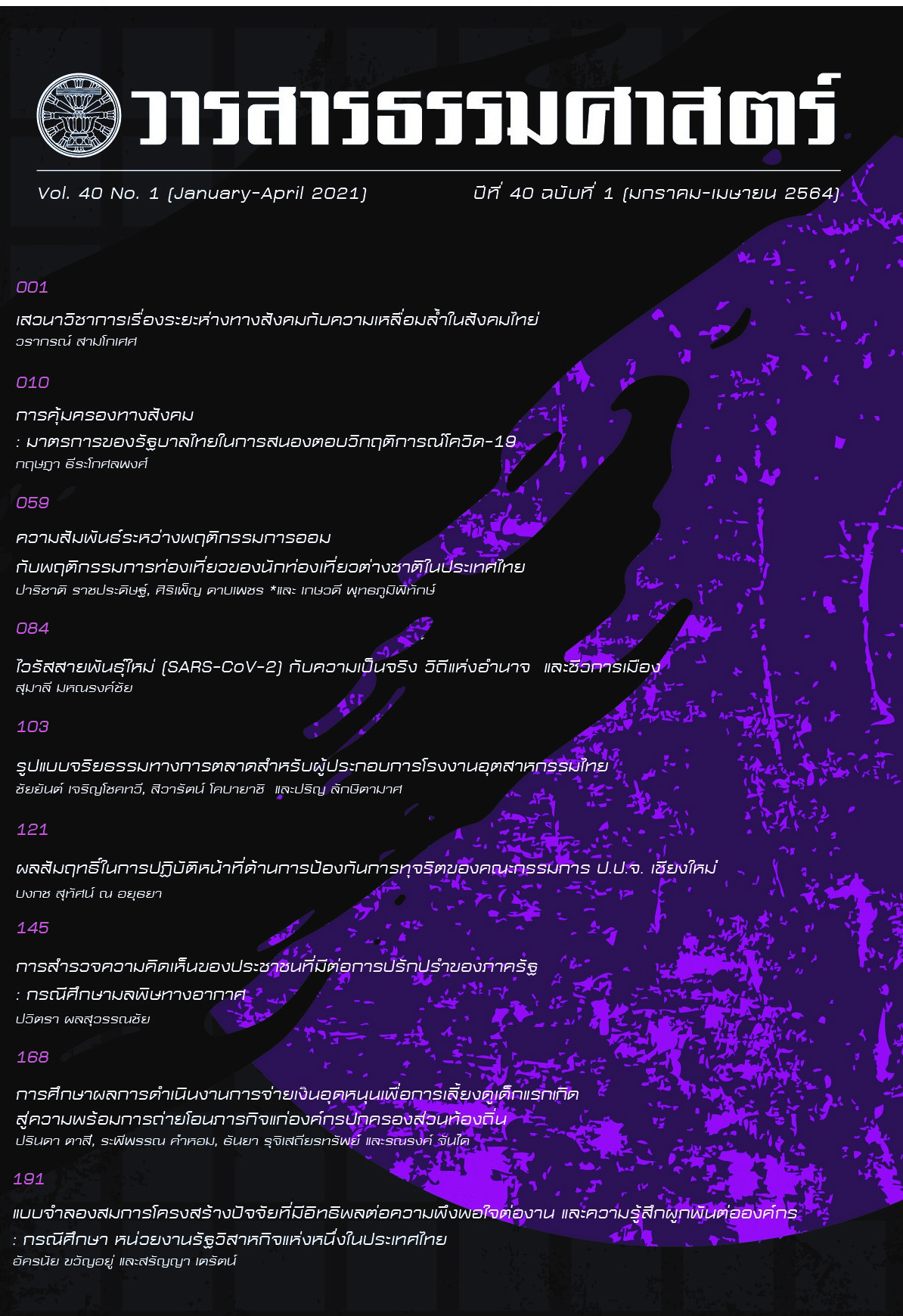Marketing Ethics Model of Thai Manufacturers
Main Article Content
Abstract
The research aims to study the development and validity check of marketing ethics model for Thai Manufacturers. The survey research and development method are employed. Questionnaires were collected from 573 Thai Manufacturers. The data analysis uses the secondary confirmatory factor analysis technique. The research findings indicated that the developed model was parallel with the empirical data consisted of 35 indicators formed 6 factor components as factor 1: marketing ethics of employees toward entrepreneurship with 5 indicators, factor 2: marketing ethics of entrepreneurs toward competitors with 2 indicators, factor 3: marketing ethics of entrepreneurs toward government with 7 indicators, factor 4: marketing ethics of entrepreneurs toward customers with 6 indicators, factor 5: marketing ethics of entrepreneurs toward employees with 9 indicators and factor 6: marketing ethics of entrepreneurs toward society with 6 indicators respectively. Each component had convergent validity because the construct reliability was more than 0.60 and the factor loading was more than 0.30.
Article Details
References
Arbuckle, J. J. (1995). AMOS user, s guide. Chicago: Small Waters Corporation, 529.
Bollen, K. A. (1989). Structure equations with latent variables. New York: John Wiley & Sons, 257-258.
Buchholtz, R. A. (1989). Fundamental Concept and Problems in Business Ethics. New Jersey: Prentice Hall, 4.
Byrne, B. M. (2001). Structural equation modeling with AMOS: Basic concepts, applications, and programming, Hahwah. New Jersey: Lawrence Erlbaum Associates.
Cochran, W. G. (1977). Sampling Techniques. (3rd ed.). New York: John Wiley & Sons, 203.
Cronbach, L. J. (2003). Essential of psychology testing. New York: Hanper Collishes.
Ferrell, O. C., Fraedrich, J., & Ferrell, L. (2000). Business Ethic: Decision Making and Case. (4th ed.). New York: Mifflin Company, 18.
Frederick, W. C., Post, J. E., & Davis, K. (1992). Business and Society: Cooperate Strategy Public Police Ethic. (7th ed.). New York: McGraw-Hill, 8.
Hair, J. F., Anderson, R. E., Tatham, R. L., & Black, W. C. (2010). Multivariate data analysis. (7th ed.). Upper Saddle River, NJ: Prentice Hall.
Hatcher, L. (1994) . A step-by-step approach to using the SAS system for factor analysis and structural equation modeling. Cary, NC: SAS Institute, 331.
Hoogland, J. J., & Boomsma, A. (1998). Robustness studies in covariance structure modeling: An overview and a meta-analysis. Sociological Methods & Research, 26(3), 329-367.
Institute for Management Education for Thailand. (2018). Business Ethics. Retrieved November 11, 2018, from http://www.imetthai.com/ethicsall.php.
Kelloway, E. K. (1998). Using LISREL for structural equation modeling. New Jersey: Sage Publication.
Kline, P. (1994). An easy guide to factor analysis. London & NY: Routledge, 28-41.
Nash, L. (1990). Good Intentions Aside, A manager’s Guide to Resolving Ethical Problem. Boston: Harward Business School Press, 5.
Silván, M. (1999). A model of adaptation to a distributed learning environment. (Progradu thesis in education). Finland: University of Jyväskylä, 42.
Taro, Y. (1973). Statistic: An introductory analysis. New York: Harper & Row, 1,089.
Velasquez, M.G. (2002). Business ethics: Concept and case. (5th ed.). New Jersey: Prentice Hall. 13.
Weiss, J. W. (2 0 0 3 ). Business ethics: A stakeholder and issue management approach. (3rd ed.). Canada: South-Western, 7.
Wilkie, A. D. (1986). A stochastic investment model for actuarial use. Transactions of the Faculty of Actuaries, 39, 341–403
กรมโรงงานอุตสาหกรรม. (2560). แนวทางปฏิบัติสําหรับผู้ประกอบการอุตสาหกรรม ตามเกณฑ์ มาตรฐานความรับผิดชอบของผู้ประกอบการอุตสาหกรรมต่อสังคม. กรุงเทพฯ: อมรินทร์พริ้นติ้งแอนด์พับลิชชิ่ง, 4.
กรมโรงงานอุตสาหกรรม. (2561). มาตรฐานความรับผิดชอบของผู้ประกอบการอุตสาหกรรมต่อ สังคม. กรุงเทพฯ: อมรินทร์พริ้นติ้งแอนด์พับลิชชิ่ง, 2-3.
กรมโรงงานอุตสาหกรรม. (2561). สถิติสะสมจํานวนโรงงานที่ได้รับอนุญาตให้ประกอบกิจการ (เปิดดําเนินการ) ตาม พ.ร.บ.โรงงาน พ.ศ. 2535 จําแนกตามหมวดอุตสาหกรรม ณ สิ้นปี พ.ศ.2560. สืบค้น 31 มกราคม 2561,จาก http://www.diw.go.th/hawk/ content.php?mode=spss61
กัลยา วานิชย์บัญชา. (2560). การวิเคราะห์สถิติขั้นสูงด้วย SPSS for Windows. (พิมพ์ครั้งที่ 12). กรุงเทพฯ: สามลดา, 75-78.
ณรงค์ โพธิ์พฤกษานันท์. (2551). ระเบียบวิธีวิจัย. กรุงเทพฯ: เอ็กซเปอร์เน็ท, 52-60. นงลักษณ์ วิรัชชัย. (2555). ความสัมพันธ์โครงสร้างเชิงเส้น (LISREL): สถิติวิเคราะห์สําหรับการวิจัย ทางสังคมศาสตร์และพฤติกรรมศาสตร์. กรุงเทพฯ: สํานักพิมพ์แห่งจุฬาลงกรณ์ มหาวิทยาลัย.
พงศ์ศรัณย์ พลศรีเลิศ. (2558). จริยธรรมทางการตลาดออนไลน์ที่มีผลต่อความเชื่อมั่นของ ผู้บริโภค. สืบค้น 7 พฤษภาคม 2560, จาก https://phongzahrun.wordpress. com/category/ marketing/
ศศิวิมล สุขบท. (2550). จริยธรรมการตลาดของนักธุรกิจไทย. ภาควิชาบริหารธุรกิจ, คณะ วิทยาการจัดการ, มหาวิทยาลัยสงขลานครินทร์. สงขลา.
สํานักงานคณะกรรมการพัฒนาการเศรษฐกิจและสังคมแห่งชาติ. (2556). สถิติรายได้จากส่งออก อุตสาหกรรมเครื่องแต่งกายของไทย ปี พ.ศ. 2555. กรุงเทพฯ.
สํานักงานเศรษฐกิจอุตสาหกรรม. (2557). อุตสาหกรรมเครื่องแต่งกายไทย...มุ่งขยายฐานการผลิต ไปเมียนมาร์ .สืบค้น 27 มกราคม 2560, จาก
http://www.oie.go.th/sites/default/files/attachments/publications/oie_share_vol30sep2557.pdf
สํานักงานอุตสาหกรรมจังหวัดศรีสะเกษ. (2558). กฎหมายโรงงานที่ผู้ประกอบการควรรู้โรงงาน. สืบค้น 27 มกราคม 2560, จาก http://sisaketindus.tripod.com/about/prb4. html สุวิมล ติรกานันท์. (2550). ระเบียบวิธีวิจัยทางสังคมศาสตร์: แนวทางปฏิบัติ. กรุงเทพฯ: โรงพิมพ์จุฬาลงกรณ์มหาวิทยาลัย, 44-46

